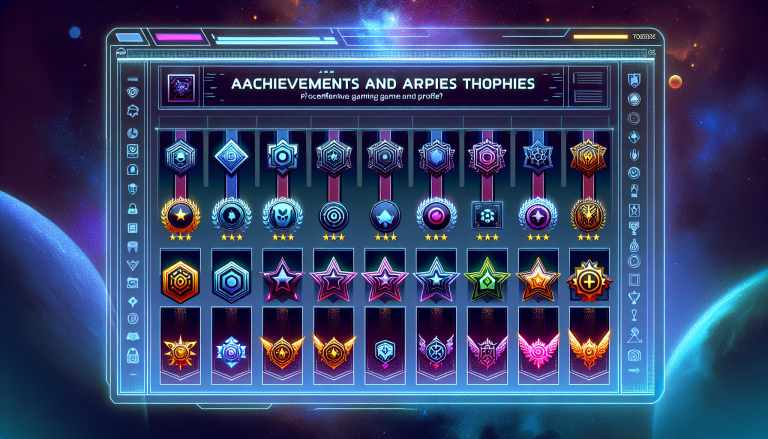Introduction to Classic Video Game Franchises
Hey there, fellow gamer! Are you ready to dive into the world of classic video game franchises? Strap in, because we’re about to embark on an exciting journey down memory lane!
Classic video game franchises hold a special place in the hearts of gamers worldwide. They have captivated us with their timeless gameplay, iconic characters, and unforgettable experiences. Whether you’re a nostalgic fan or a curious newcomer, understanding the significance of these franchises is essential to appreciating the evolution of gaming.
Now, you might be wondering, what exactly defines a classic video game franchise? Well, my friend, it’s all about longevity. These franchises have withstood the test of time, spanning multiple generations and platforms. They have become cultural phenomena, shaping the gaming industry as we know it today.
Take, for example, the legendary Super Mario franchise. Since its debut in 1985, Mario has become a household name, beloved by gamers of all ages. With its charming platforming gameplay, colorful worlds, and catchy tunes, it’s no wonder Mario has remained a staple in the industry for over three decades.
Another iconic franchise that has stood the test of time is The Legend of Zelda. From its humble beginnings on the Nintendo Entertainment System to its latest breathtaking installment on the Nintendo Switch, Zelda has consistently delivered epic adventures filled with puzzles, exploration, and a rich lore.
So, why do these classic video game franchises continue to capture our imagination? Well, one key element that sets them apart is their ability to tell compelling stories.
The Importance of Storytelling in Retro Games
Storytelling is the backbone of any great video game, and classic franchises excel in this department. Back in the day, when graphics were limited and voice acting was a luxury, developers had to rely on the power of storytelling to engage players.
Think about it: when you play a retro game, you’re not just controlling pixels on a screen. You’re immersing yourself in a carefully crafted narrative, where every level, every boss, and every character has a purpose. These stories create a sense of adventure and wonder, drawing us into their worlds.
For instance, the original Final Fantasy game on the NES may look simplistic by today’s standards, but it introduced players to a vast, fantasy realm filled with warriors, mages, and a villainous force threatening to engulf the world in darkness. The game’s narrative, though minimalistic, allowed players to imagine and connect with the characters and their plight.
Similarly, the Metal Gear Solid franchise revolutionized storytelling in video games. With its complex plot, political intrigue, and cinematic cutscenes, it blurred the lines between gaming and movies. Hideo Kojima, the mastermind behind Metal Gear Solid, once said, “Games are stories that you take part in.” And indeed, these games immerse players in a narrative that unfolds as they progress, making them active participants in the storytelling process.
In conclusion, classic video game franchises are not merely about nostalgia or pixelated graphics. They are about captivating stories that transport us to different worlds and ignite our imagination. So, whether you’re a fan of platformers like Super Mario or engrossing RPGs like The Legend of Zelda, remember to appreciate the power of storytelling that these franchises possess. Happy gaming!
The Importance of Storytelling in Retro Games
Hey there, fellow gamers! Today, let’s dive into the fascinating world of classic video games and explore the crucial role that storytelling plays in these retro gems. Strap on your nostalgia goggles, grab your favorite controller, and let’s get started!
Back in the day, video games were more than just mindless button-mashing. They were immersive experiences that transported players to imaginative worlds, and storytelling was at the heart of it all. Unlike modern games with their flashy graphics and complex mechanics, retro games relied heavily on engaging narratives to captivate players.
One of the reasons storytelling was so important in classic video games is that it helped to create a sense of purpose for the player. Whether it was rescuing a princess from a dastardly villain or saving the world from impending doom, a strong narrative provided a clear objective and motivation for the player to keep going.
Moreover, storytelling in retro games often served as a means of world-building. By weaving together a rich tapestry of lore and history, game developers were able to create immersive universes that players could truly get lost in. From the Mushroom Kingdom of Super Mario Bros. to the sprawling lands of Hyrule in The Legend of Zelda, these games transported players to vivid and memorable worlds.
But why does storytelling matter in video games? Well, my friends, it’s all about immersion. When a game has a compelling narrative, it draws players into its world, making them feel like an integral part of the story. This immersion is crucial for the overall gaming experience, as it allows players to emotionally connect with the characters and events unfolding on the screen.
Think about it – when you’re playing a retro game with a gripping story, you become invested in the outcome. You care about the fate of the characters, their struggles, and their triumphs. It’s this emotional engagement that keeps you coming back for more, even long after you’ve put down the controller.
So, what can we learn from the importance of storytelling in retro games? Well, for game developers, it’s a reminder that graphics and flashy gameplay mechanics are not enough to create a truly memorable gaming experience. A strong narrative, with well-developed characters and a compelling story arc, is what truly captivates players and keeps them hooked.
For us, as players, it’s a lesson in appreciating the art of storytelling in video games. The next time you fire up your favorite retro game, take a moment to immerse yourself in the narrative. Let yourself be transported to a bygone era where storytelling reigned supreme and see just how much it enhances your gaming experience.
And that’s a wrap for today’s exploration of storytelling in retro games. Remember, it’s not just about the pixels and polygons – it’s about the stories that shaped our gaming memories. Until next time, happy gaming!
World-building in Classic Video Game Franchises
Have you ever found yourself completely engrossed in a video game, feeling as though you’ve been transported to another world? One of the key elements that contribute to this immersive experience is world-building. And when it comes to classic video game franchises, world-building is taken to a whole new level.
In retro games, world-building goes beyond creating visually stunning environments. It involves constructing a rich and cohesive universe that players can explore and become a part of. From the iconic Mushroom Kingdom in Super Mario to the vast lands of Hyrule in The Legend of Zelda, these franchises have captured the hearts of gamers worldwide with their intricate worlds.
So, what exactly makes world-building in classic video game franchises so special? Let’s dive in and find out!
First and foremost, world-building sets the stage for the player’s journey. It establishes the rules, the history, and the lore of the game’s universe. Take, for example, the Metroid franchise. From the very beginning, players are introduced to a futuristic world where they assume the role of bounty hunter Samus Aran. Through exploration and discovery, they uncover the secrets of the universe, piecing together its complex history. This sense of discovery and immersion is what keeps players coming back for more.
Additionally, world-building in retro games allows for a sense of escapism. As players, we can temporarily step away from reality and become immersed in these vibrant and fantastical worlds. Whether it’s the post-apocalyptic wasteland of Fallout or the whimsical realm of Final Fantasy, these games provide an opportunity to experience something beyond our everyday lives. It’s a form of entertainment that allows us to temporarily escape our worries and immerse ourselves in a new and exciting adventure.
Furthermore, world-building plays a crucial role in creating memorable characters and storylines. The environments, cultures, and histories of these game worlds shape the characters that inhabit them. Just think about the iconic characters from retro games like Sonic the Hedgehog or Mega Man. These characters have become beloved not only for their gameplay mechanics but also for their place within their respective game worlds. They are products of their environment, and their stories are intrinsically tied to the world around them.
In addition to providing a captivating experience for players, world-building in classic video game franchises also serves as a source of inspiration for other forms of media. It’s not uncommon to see retro game worlds being adapted into movies, TV shows, and even tabletop role-playing games. The rich lore and world-building of franchises like The Elder Scrolls and Final Fantasy have spawned entire fandoms and creative communities that continue to explore and expand upon these game worlds.
In conclusion, world-building in classic video game franchises is a fundamental aspect that contributes to the immersive and captivating experience these games offer. The intricate universes, rich histories, and memorable characters created through world-building allow players to escape reality and embark on epic adventures. So, the next time you fire up your favorite retro game, take a moment to appreciate the meticulous world-building that went into creating that virtual world. It’s what makes these games truly timeless.
Impact of Lore on Immersion in Retro Games
Do you remember the first time you played a retro video game? The thrill of exploring a pixelated world, battling enemies, and uncovering secrets? Retro games have a unique charm that continues to captivate players to this day. One crucial element that contributes to the immersive experience of these games is the rich lore that surrounds them.
Lore refers to the background story, history, and mythology of a game’s universe. It provides players with a deeper understanding of the game world, its characters, and their motivations. The lore acts as a foundation for the game’s narrative, adding depth and complexity to the overall gaming experience.
In retro games, the impact of lore on immersion is particularly significant. Due to the limitations of early gaming technology, developers had to rely heavily on storytelling to engage players. While the graphics may have been simplistic, the lore added layers of depth that drew players into the game world.
Take, for example, the iconic “The Legend of Zelda” franchise. From its inception, this series has been known for its rich lore. Each game is set in the fictional land of Hyrule, a world filled with mystical creatures, ancient prophecies, and legendary artifacts. As players progress through the games, they unravel the secrets of Hyrule’s history and uncover the significance of their quest. The lore of “The Legend of Zelda” not only enhances the gameplay but also adds emotional weight to the player’s actions.
Another classic franchise that emphasizes the impact of lore is “Final Fantasy.” Known for its intricate and expansive narrative, each game in the series is set in a unique, fully realized world. The lore of “Final Fantasy” delves into the histories of different nations, the conflicts between them, and the personal journeys of the protagonists. This attention to detail allows players to fully immerse themselves in the world, forging emotional connections with the characters and their struggles.
The impact of lore on immersion in retro games is not limited to RPGs. Even platformers and action-adventure games benefit from a well-crafted narrative. Take “Super Mario Bros.” as an example. While the main focus of the game is on platforming and gameplay mechanics, the lore surrounding the Mushroom Kingdom and its inhabitants adds another layer of enjoyment. Discovering the backstory of characters like Bowser, Princess Peach, and the Toads provides context for the player’s actions and creates a more immersive experience.
In conclusion, the impact of lore on immersion in retro games cannot be overstated. The rich storytelling and world-building in classic video game franchises add depth, emotion, and context to the player’s journey. Whether you’re exploring the vast landscapes of Hyrule, unraveling the mysteries of a Final Fantasy world, or stomping on Goombas in the Mushroom Kingdom, immersing yourself in the lore of these retro games enhances the overall gaming experience.












